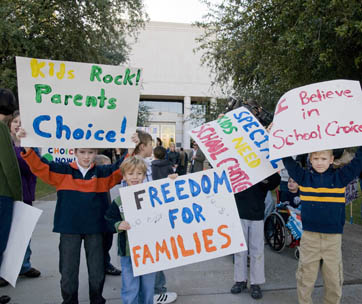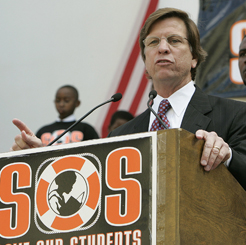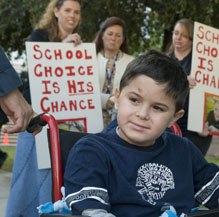An interview with Jay Greene about vouchers for disabled kids is available here.

The big battles over school vouchers in American education have focused on programs serving low-income children who live in urban areas. Milwaukee’s program, begun in 1990, is the biggest and oldest in the country, and the District of Columbia effort, funded by the federal government, has been the most carefully studied. Both have been focal points of intense, partisan disputes, and both have been threatened by legislative actions in the past several months. But, even when they are considered together, those two programs are not as large as a hardly known, originally noncontroversial voucher innovation, the special education voucher. Four states—Florida (1999), Georgia (2007), Ohio (2003), and Utah (2005)—have special education voucher programs that together serve more than 22,000 students.
Special education voucher laws are very simple. The parents of any child found in need of a special education (in Ohio, only students with autism) can ask the school district to pay for their child’s education at a school the parent has identified as appropriate.
Special education vouchers have a political advantage that vouchers for low-income students lack: they can benefit not only the poverty-stricken disadvantaged, almost never a politically potent interest group, but also anyone who has a child with disabilities, a population that crosses all social and economic boundaries. The concept also stands on particularly strong constitutional grounds, inasmuch as special education vouchers add nothing in principle to the rights established by federal law in 1974. Part of the historic extension of equal educational opportunity rights to the disabled, Public Law 94-142, the Education of All-Handicapped Children Act, now known as the Individuals with Disabilities Education Act (IDEA), was one of the most popular pieces of federal education legislation ever enacted.
That law has four key provisions: 1) every child, no matter how disabled, has a right to a free and appropriate education, which can take place in either a public or private setting; 2) an Individualized Education Plan (IEP) must be designed for each child in consultation with his or her parents; 3) the child should be educated in the “least restrictive environment”; and 4) parents can object to the educational provisions for their child by requesting a “due process” hearing with an independent hearing officer, whose decisions can be appealed to the courts (see sidebar). But schools tend to win most legal challenges brought by parents. Given the long odds and financial and psychological toll of suing the same people who take care of their child each day, most parents tend to accept whatever services are offered, even if the services fall well short of those required by law.
High Cost of Winning
In 1999, Joseph Murphy was a 9th-grade student with dyslexia and several other cognitive disabilities. His parents felt that the New York public high school’s Individualized Education Plan (IEP) for their son was not adequate. They followed the protocol of the Individuals with Disabilities Education Act (IDEA) and sued Arlington Central School District, requesting that the school district cover tuition at a private school that could meet their son’s needs.
The Murphys prevailed in the district court. Arlington was ordered to pay the tuition costs for Joseph at the private school. In accordance with IDEA, the school district was also required to pay the plaintiffs’ fees and the costs of the lawsuit, which, for the Murphys, included a bill for $29,350 from Marilyn Arons, an education consultant they had hired as an expert witness.
The school district refused to pay these expenses, claiming that the Murphys should not be reimbursed for the costs of Arons’s services, as she was not an attorney. In July 2003 the district court ruled that under IDEA the cost of an expert consultant was reimbursable and that the school district would indeed have to pay. The school district appealed, and in March 2005 the second circuit court affirmed the previous decision.
The school district then appealed to the Supreme Court to determine whether, according to IDEA, costs beyond attorney’s fees were reimbursable. In June 2006, the Supreme Court decided (6 to 3) that IDEA’s stipulations for reimbursement did not include expert witness fees, thereby absolving the school district of paying for the Murphys’ expert.
Suing for tuition reimbursement for their son’s private school and then fighting to be reimbursed for the costs of the expert who had helped them win took Joseph Murphy’s parents seven years. The Supreme Court ruling left the burden of paying the $29,350 on the Murphys’ shoulders.
As special education has evolved over the decades since IDEA was enacted, public school districts have provided most of the special education services students have required. But a small percentage of students are educated at private schools, most often because the district has deemed that facility to be the most appropriate and to provide the least restrictive environment, given the nature and severity of the child’s disability. Many of the private schools serving the disabled have a religious affiliation, but that has not proven to be a barrier to government funding of student placements under IDEA.
As of 2007, there were 5,978,081 students in special education nationwide, with fewer than 100,000 in private placements. Only 67,729 were being served by private schools at parental initiative, a mere 1.1 percent of disabled students, and a trivial 0.14 percent of the 49.6 million students in public education. Students placed in private schools are more likely to be autistic, have multiple disabilities, or suffer from emotional disturbances than those students who receive services in the public schools (see “Debunking a Special Education Myth,” check the facts).
Although few and far between, private placements nonetheless are an important constitutional precedent for special education vouchers, as the latter constitute only an extension of a long-standing practice that dates back to the civil-rights revolution. But unlike the procedures established under IDEA, school-voucher laws give parents the right to select a private placement without having to convince public school officials of the need for such services, to say nothing of the legal costs of proving to a hearing officer, or a state court judge, that the decision of the school district was in error. The rights of parents are seemingly identical under IDEA and under special education voucher laws, but the ease with which parents can exercise those rights is profoundly different.

The Debate
Almost 15 percent of students in the United States are said to have a disability under the procedures established by IDEA, so in states with special education vouchers, the potential for program growth is considerable. As the opportunity for private placement with a special education voucher becomes better known to parents, and as private providers become aware of the possibility of a larger clientele, one can anticipate an inexorable growth in the size and popularity of these programs.
Further expansion is likely to face some obstacles, however, as the programs become large enough to threaten vested interests. Arizona’s special education voucher law was struck down by the state courts after a challenge from the teachers union and civil liberties groups, which claimed that the law violated a state constitutional provision barring any public funds from flowing to religious institutions. Whether these state “Blaine Amendments,” named after the 19th-century presidential candidate who promoted anti-Catholic bigotry nationwide, will survive federal constitutional muster is not yet known. And whether other states of the 37 that have Blaine Amendments will interpret them as restrictively as Arizona or will follow Wisconsin’s example and still permit vouchers to be used at religiously affiliated schools is also not yet known.
In addition to legal challenges, opponents of special education vouchers are beginning to advance political and educational arguments against the idea as new programs are being considered in states such as Texas, Pennsylvania, North Carolina, and South Carolina, and the existing Ohio program is poised to expand.
Opponents raise several arguments to which answers can be given from recent studies of existing special education voucher programs. A number of the studies were carried out by research teams in which Jay Greene participated; in the remainder of this essay we will refer to those studies as “our” research.

1. Is Current Law Adequate?
One of the most frequently heard claims is that such vouchers are unnecessary, as disabled students already have the right, under IDEA, to private placement, if that is the appropriate setting for their education. Andrew Rotherham, the well-known blogger for Education Sector, dismisses the need for such vouchers on the grounds that “many (in real numbers not percentage terms) special education students attend private schools at public expense as a result” of a provision in the “Individuals With Disabilities Education Act…for students with exceptional needs that the public schools cannot meet,” and this existing provision is “adequate to the task.”
But this claim ignores the complex procedures that must be followed in order to arrange for a private placement, a primary reason such placement is quite rare. As the United States Supreme Court noted in its recent Forest Grove School District decision, pursuing private placement through the legal system is “‘ponderous’ and therefore inadequate to ensure that a school’s failure to provide a [free and appropriate public education] is remedied with the speed necessary to avoid detriment to the child’s education.” And school districts win most legal struggles with parents over private placement. According to Thomas Mayes and Perry Zirkel’s empirical analysis of this type of case, “school districts won the clear majority (62.5%) of the decisions.”
Given the low probability of victory as well as the considerable time, expense, and psychological discomfort involved in waging a legal battle, it isn’t surprising that private placements are rare, especially among families who lack the wealth and sophistication required to navigate the legal system successfully.
Special education vouchers essentially use public funds to democratize access to private placement by reducing legal and financial barriers. In Florida, where the McKay Scholarship for Students with Disabilities program has offered vouchers to disabled students since 1999, vouchers allow 6.7 percent of special education students to be educated in private schools at public expense. That is six times the nationwide average for private placement. Current practices for securing private placement elsewhere are hardly “adequate to the task,” that is, if the task is helping disabled students find an appropriate alternative to their assigned public school.

2. Will Costs Rise?
Won’t expanding access to private schools for disabled students impose significantly greater costs on the public? The People for the American Way and the Disability Rights Education and Defense Fund (PFAW/DREDF) expressed this fear as fact in their joint 2003 report on Florida’s McKay Scholarship program: “The costs of the McKay voucher program have escalated rapidly and have financially punished public schools around the Sunshine State.”
Fortunately, the facts don’t support the PFAW/DREDF claim. It is true that the overall cost of special education has become a significant financial issue for school districts nationwide as enrollments have steadily grown over the years, although our previous research found that the cost has been widely exaggerated in the media. However, vouchers are unlikely to increase the burden on districts: Special education voucher laws stipulate that the voucher amount should reflect the severity of the disability, that is, students who have more severe disabilities receive more generous vouchers, and that the cost to the district may not exceed the average cost the state pays for the education of children with similar conditions.
In Florida, eligible students are provided with a voucher equivalent to the lesser of the amount the assigned public school would have spent on the child and the tuition at the accepting private school. According to the Florida Department of Education, the value of McKay scholarships in 2006–07 ranged from $5,039 to $21,907, with an average of $7,206. Given that Florida public schools spend close to $17,000 per disabled student and that the McKay program contains a roughly representative distribution of disability types, taxpayers are actually saving quite a bit of money with special education vouchers, and public school districts are certainly not being “financially punished.”

3. Will Enrollments Rise?
Even if special education vouchers lower the public expenditure for each disabled student who receives a voucher, the vouchers might contribute to higher total costs if they increase the likelihood that students would be classified as disabled. Andrew Rotherham and Sara Mead expressed this concern in a paper for the Progressive Policy Institute in 2003: “Special education vouchers may actually exacerbate the over-identification problem by creating a new incentive for parents to have children diagnosed with a disability in order to obtain a voucher.”
Again, the facts do not support the fear. Though no one disputes that disabilities are real and that disabled students are more expensive to educate, it is not true that vouchers will necessarily increase the identification of disabilities, thereby raising overall education costs. It is current government funding policies that generate incentives for over-identification of disabilities. A number of studies have found a higher incidence of identified disabilities in those states that provide districts with additional dollars for each student diagnosed as disabled. Other states award a special education grant to each district, based on past numbers of disabled students, thereby reducing any incentive to over-identify students with disabilities. Our research has shown that when a state shifts away from paying for each incidence of disability to a “census” approach, the growth in special education enrollments slows. Other research confirms the pattern: Using district-level data, Julie Cullen finds that financial incentives explained 40 percent of the growth in special education in Texas during the early 1990s, and Sally Kwak finds a similar result in California.
Special education vouchers provide a different incentive. They discourage school districts from over-identifying disabled students, because any student identified as disabled becomes a potential choice student who might leave the district for a private school, reducing district revenue received from the state.
Our research has shown that vouchers have in fact slowed growth in special education enrollments in Florida. In a new study, we examined the impact of vouchers on the likelihood that Florida students would be placed in special education. We looked at whether the probability that a student would be identified as having a specific learning disability in Florida changed as more private schools that accepted McKay scholarships opened near the student’s public school. With more such schools nearby, students would have greater opportunities to leave if they were classified as disabled and therefore became eligible for a voucher. The willingness of public schools to put students into special education might be constrained if those schools feared that students would walk out the door with a voucher and all of their funding.
In fact, that is exactly what we found. The addition of 7.6 private schools that accept McKay funding within five miles of a public school, which is the average, reduces the probability that a student will be identified as having a specific learning disability by 15 percent. The evidence suggests that, rather than expanding special education, as Rotherham and Mead feared, introducing special education vouchers places some constraint on the rapid growth in students placed in special education.

4. Will Sufficient Services Be Provided?
If special education vouchers don’t increase costs, critics allege, then providers must skimp on services. Emory University professor Ann Abramowitz warned Georgians against adopting a special education voucher program that ultimately was enacted in that state, arguing that it “risks depriving many special needs students of services that they vitally need. Federal law requires public schools to provide appropriate services to children with special needs…. Parents would surrender these rights when they opt for a voucher under the proposed legislation.”
This is inaccurate. Parents don’t lose rights with special education vouchers; they only gain an additional mechanism for making the rights of their disabled children a reality. Even where special education vouchers are adopted, families can always choose to pursue their right to appropriate services in public schools through the legal system. Vouchers simply offer those families an alternative to engaging in a legal struggle or accepting subpar services. Instead, they can use their voucher-derived market power to purchase the services their disabled children need. If the market doesn’t provide satisfactory outcomes, parents can always return to the public schools with their relatively impotent legal rights.
The empirical research shows that when parents are empowered with vouchers, they are actually more likely to obtain necessary services. In another study, we surveyed participants in Florida’s McKay voucher program to see how likely they were to get services in their private school relative to their previous public school. Only 30.2 percent of voucher participants said they received all services required under federal law from their public school, while 86 percent reported their McKay school provided all the services they promised to provide. In addition, Virginia Weidner and Carolyn Herrington found through a large survey that “almost 90% of McKay respondents…were satisfied or very satisfied with the school their child attends, whereas only 71.4% of public school respondents were satisfied or very satisfied with the school their child attends.”
These families were more likely to get what they needed from private schools, even though they had no legal rights to specific services from those schools; they were less likely to get what they needed from the public schools, where they were legally entitled to those services. Market power can sometimes deliver better results than procedural rights. With special education vouchers, families get both: the right to an appropriate education from public schools and the option to purchase that appropriate education from private schools.

5. Will Some Students Be Left Behind?
But might the departure from public schools of some special education students and the revenue they generate undermine the ability of the remaining disabled students to get an appropriate education? Vouchers could drain resources and talent from the public schools, making it harder for them to serve their special education students. On the other hand, options for disabled students to leave and take resources with them might motivate public schools to attend to the needs of their students more closely and serve them better.
The latter seems to be the case. In a 2008 study, we examined whether the academic achievement of special education students was affected by the number of options they had to leave their public school with a voucher. In Florida, as more private schools that accept McKay funding opened near each public school, the standardized test scores of disabled students who remained in public schools significantly increased. The addition of about seven public schools with McKay funding within five miles of a public school improved the academic achievement of special education students by about .05 of a standard deviation. Contrary to common misconceptions, virtually all disabled students in public schools take the state-mandated test in Florida, so improvement in test results suggests that schools were serving those students better when they faced more competition from the McKay program. Vouchers do not drain public schools of their ability to serve disabled students; instead, schools are pushed to serve those students better.
6. Are Private Schools Accountable?

Special education vouchers appear to improve access to desired services for the students who use them, while also improving outcomes for the disabled students who remain in public schools. But the country’s largest teachers union, the National Education Association, still frets that the program lacks sufficient accountability for results: “Voucher students are not included in state assessments, so taxpayers have no way of knowing how the voucher funds have been spent, and how students have fared.”
The simplest solution is to add a testing requirement to special education voucher programs similar to the testing requirements found in a number of other voucher programs. It might be best, however, not to require state accountability testing in a special education voucher program. With the difficulties disabled students face and the highly varied goals and criteria for success that may be appropriate for each student, state accountability testing is not always helpful in assessing the academic progress of individual special education students. Educational goals and assessments often need to be customized to individual circumstances.
Even when disabled students are in public schools with Individual Education Plans, accountability for progress on the goals contained in those IEPs rests primarily with the parents. If schools fall short, the public and policymakers would never know. Parents would have to detect the shortcomings and do something about it. The situation is no different in private schools that accept a special education voucher. If the private schools fall short, parents would have to detect it and do something about it. The only difference is that without vouchers the only thing that could be done is to pursue an expensive and time-consuming legal process; with vouchers, the parents would have the option of finding better services somewhere else.

It’s also important to note that we do not always require accountability by measuring outcomes whenever public funds are distributed, even in education. For example, large public sums are devoted to higher education in both public and private universities and yet no one is required to take accountability tests. Preschool is increasingly subsidized directly and indirectly by the government and still we do not make preschoolers take accountability tests.
Despite the frequency with which public programs rely on beneficiaries to hold the quality of services accountable, Sara Mead asserts in an Education Sector report that, “accountability to parents alone is insufficient to protect the public interest or ensure taxpayer money is used well.” It is unclear why these critics find parents of disabled 5th graders unreliable for accountability purposes, but find parents of students in preschool or university sufficiently competent.
Besides, the research evidence suggests that special education vouchers are benefiting both students and taxpayers. They improve the ability of disabled students to find appropriate services. They save taxpayers money, because the average voucher ends up costing less than educating the same student in public school and because the voucher curbs public-school financial incentives to inflate the special education rolls. And special education vouchers even improve the quality of services for the disabled students who remain in public schools because those schools risk losing students to the voucher program if they do not serve the students well. This all sounds like real accountability for results.
Most important, special education vouchers change the mechanism by which we ensure services for disabled students. Rather than forcing dissatisfied families to accept subpar services or to pursue legal action for relief, vouchers permit a lower-conflict, lower-cost method for resolving disagreements about the adequacy of public school efforts.
Jay Greene is professor of education reform at the University of Arkansas and senior fellow at the Manhattan Institute. Stuart Buck is a doctoral student in education reform at the University of Arkansas and author of Acting White: An Ironic Effect of Desegregation (forthcoming, Yale University Press).


